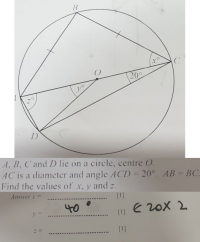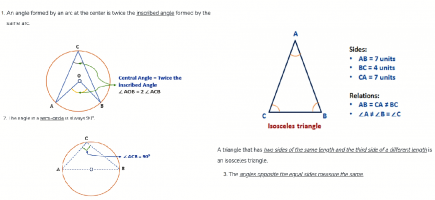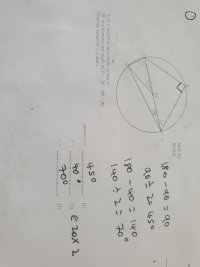You are using an out of date browser. It may not display this or other websites correctly.
You should upgrade or use an alternative browser.
You should upgrade or use an alternative browser.
Circle theorem question
- Thread starter ian goh
- Start date
Dr.Peterson
Elite Member
- Joined
- Nov 12, 2017
- Messages
- 16,092
What special kind of triangle is ABC?Hello, I am stuck on this question where I can find y but don't understand how to find x and z, I am not sure which circle theorem rule to use any help would be appreciated thanks!
View attachment 31250
What is the measure of (minor) arc CD?
The Highlander
Full Member
- Joined
- Feb 18, 2022
- Messages
- 937
Go here and read all the way through.
The property of a circle that you appear to have used already appears after the one that seem to be ignorant of at present (or you would have been able to complete the task), so, if you reach that particular property and still don't know how to proceed, then you will need to read up again; what you need is definitely on that web page.
I trust you know what the ticks on lines AB & BC mean and that you are also familiar with the properties of isosceles triangles?
Come back and let us know how you got on, please. It would also be helpful if you would outline how you eventually arrived at your solution(s); if anything you have attempted isn't correct we can offer further advice.
The property of a circle that you appear to have used already appears after the one that seem to be ignorant of at present (or you would have been able to complete the task), so, if you reach that particular property and still don't know how to proceed, then you will need to read up again; what you need is definitely on that web page.
I trust you know what the ticks on lines AB & BC mean and that you are also familiar with the properties of isosceles triangles?
Come back and let us know how you got on, please. It would also be helpful if you would outline how you eventually arrived at your solution(s); if anything you have attempted isn't correct we can offer further advice.
The Highlander
Full Member
- Joined
- Feb 18, 2022
- Messages
- 937
I believe the measure of minor arc CD is the angle (y = 40°) that Ian has already determined (given that he knows it's twice the angle subtended at the circumference by the same arc, I presume; how else would he get that without first finding "z"?).What special kind of triangle is ABC?
What is the measure of (minor) arc CD?
It would seem to be the properties that Steven G & I have alluded to that he needs to explore: angles in a semi-circle & properties of triangles.
Dr.Peterson
Elite Member
- Joined
- Nov 12, 2017
- Messages
- 16,092
You may be misreading the figure. It is arc AD whose measure is 40°, not CD. Arc CD, which can be found using angle y, is useful for finding angle z.I believe the measure of minor arc CD is the angle (y = 40°) that Ian has already determined (given that he knows it's twice the angle subtended at the circumference by the same arc, I presume; how else would he get that without first finding "z"?).
Or, of course, you could just use triangle ADC, as pka has pointed out.
The Highlander
Full Member
- Joined
- Feb 18, 2022
- Messages
- 937
No, I am not misreading the figure. I simply presumed (wrongly, ofc) that you were referring to minor arc AD (without checking back to the diagram) because that was how he had appeared to have arrived at his answer of 40° for "y" (without first getting "z"). Mea culpa!You may be misreading the figure. It is arc AD whose measure is 40°, not CD. Arc CD, which can be found using angle y, is useful for finding angle z.
Or, of course, you could just use triangle ADC, as pka has pointed out.
I will endeavour to check your comments more carefully in future.
Your suggestion does, indeed, lead towards evaluation of angle y and the repeated hints about the angles in a semi-circle also allow for finding not only angle z (as pka suggests) but also angle x, except that he appears to be lacking the knowledge of a basic fact about isosceles triangles that would lead to the final solutions required.
Note to Ian goh: In addition to the website I mentioned already on the Properties of Circles, please also visit this website on the Properties of Triangles. Together, these sites give you all the information you need to solve your problem (and the revision won't do you any harm at all!).
The Highlander
Full Member
- Joined
- Feb 18, 2022
- Messages
- 937
Your answers are now correct. (Except for missing units! "X=45" is not the same as "X=45°". Mathematics is a language that requires a minimum level of precision.)
Were you asked to calculate the sum of the three angles? I am curious as to why you have done so; it is not pertinent to finding the individual sizes of x, y & z.
The facts (knowledge) you needed to find these angles is summarized below. You appeared to be familiar with point 1 (in the picture) but did not seem to be aware of points 2 & 3 when you came to us for assistance. Several hints were provided to lead you towards these facts and I trust that is how you eventually arrived at your answers?
Were you asked to calculate the sum of the three angles? I am curious as to why you have done so; it is not pertinent to finding the individual sizes of x, y & z.
The facts (knowledge) you needed to find these angles is summarized below. You appeared to be familiar with point 1 (in the picture) but did not seem to be aware of points 2 & 3 when you came to us for assistance. Several hints were provided to lead you towards these facts and I trust that is how you eventually arrived at your answers?
Attachments
Last edited by a moderator:
Dr.Peterson
Elite Member
- Joined
- Nov 12, 2017
- Messages
- 16,092
Tato is not the OP! We don't yet know whether the OP has learned anything.Your answers are now correct. (Except for missing units! "X=45" is not the same as "X=45°". Mathematics is a language that requires a minimum level of precision.)
Were you asked to calculate the sum of the three angles? I am curious as to why you have done so; it is not pertinent to finding the individual sizes of x, y & z.
The facts (knowledge) you needed to find these angles is summarized below. You appeared to be familiar with point 1 (in the picture) but did not seem to be aware of points 2 & 3 when you came to us for assistance. Several hints were provided to lead you towards these facts and I trust that is how you eventually arrived at your answers?
(I make that mistake sometimes, too.)
The Highlander
Full Member
- Joined
- Feb 18, 2022
- Messages
- 937
Indeed! Thank you for pointing that out. I had seen Tato's name crop up elsewhere as both questioner & contributor and just assumed this was his thread.Tato is not the OP! We don't yet know whether the OP has learned anything.
(I make that mistake sometimes, too.)
Should his posts (with the answers) not have been deleted?
Thank you for bringing it to my attention, Dr P.
I thought that y was angle at the centre so i times it by 2 from angle DCA thats how i got 40° Ill tried using the resources you sent me and I think i understand it now thanksNo, I am not misreading the figure. I simply presumed (wrongly, ofc) that you were referring to minor arc AD (without checking back to the diagram) because that was how he had appeared to have arrived at his answer of 40° for "y" (without first getting "z"). Mea culpa!
I will endeavour to check your comments more carefully in future.
Your suggestion does, indeed, lead towards evaluation of angle y and the repeated hints about the angles in a semi-circle also allow for finding not only angle z (as pka suggests) but also angle x, except that he appears to be lacking the knowledge of a basic fact about isosceles triangles that would lead to the final solutions required.
Note to Ian goh: In addition to the website I mentioned already on the Properties of Circles, please also visit this website on the Properties of Triangles. Together, these sites give you all the information you need to solve your problem (and the revision won't do you any harm at all!).
Attachments
Last edited:
The Highlander
Full Member
- Joined
- Feb 18, 2022
- Messages
- 937
Yes, you now have the correct answers.I thought that y was angle at the centre so i times it by 2 from angle DCA thats how i got 40° Ill tried using the resources you sent me and I think i understand it now thanks
I hope our suggestions helped you on your way.



